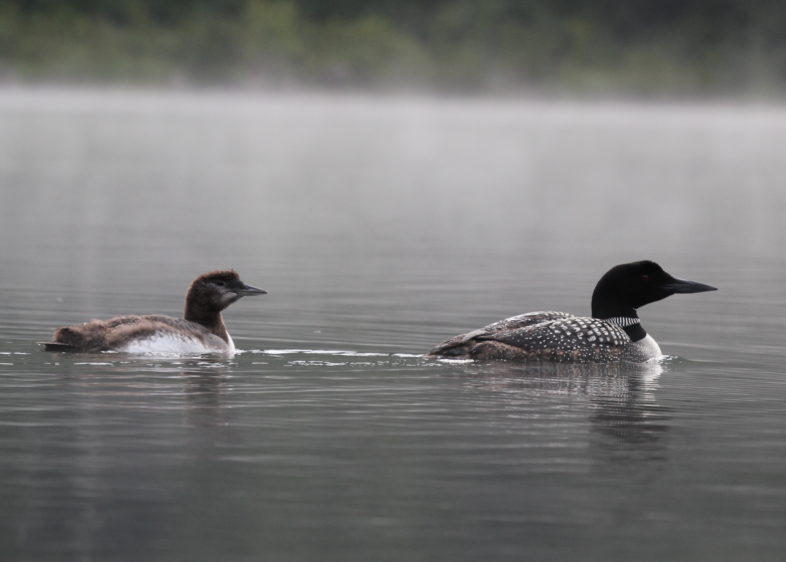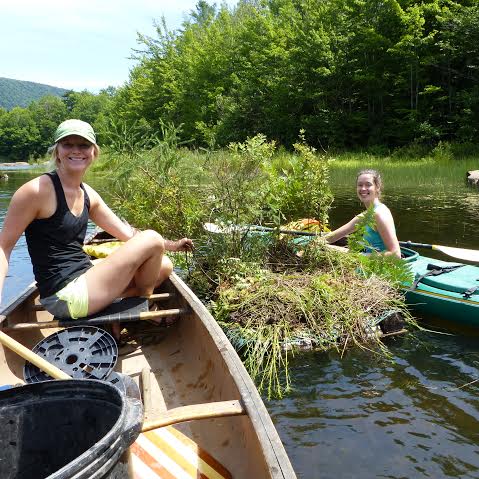
Reservoirs have played in important role in the recovery of Vermont’s loon population. Here is a six week-old Common Loon chick with an adult on Mollys Falls Reservoir. / © Janet Steward
One of the past decade’s most noteworthy successes has been expansion of the southern Vermont Common Loon population. Thirty years ago just a single pair nested on Somerset Reservoir, with a few non-breeders roaming about the area. Today, the region hosts seven nesting pairs, including three pairs on Somerset Reservoir and a brand new pair on nearby Lake Raponda. Three chicks currently reside on Somerset, while the Raponda pair is still caring for its single chick.
This success can be largely attributed to TransCanada’s stabilizing of water levels on Somerset Reservoir during the nesting period. This involves a delicate balance of predicting how big rainstorms will be and determining when to release water, as well as retaining enough water to meet minimum flow requirements for the Deerfield River. Drought years actually pose the toughest challenge for TransCanada, especially during a season with late loon nests. However, their efforts have clearly paid off, with no fewer than 38 loon chicks surviving into the fall since 1978. These chicks spend their next several years off the New England coast, and many return to southern Vermont after they reach 3 or 4 years of age. It’s very likely that a few recruits from elsewhere have also settled into the region to diversify the gene pool.
Henry Dandeneau is a retired TransCanada engineer, who had the job of checking and adjusting water levels. He fell in love with loons in the process, bought a boat upon retirement that can handle 2,000-acre Somerset Reservoir, and now monitors many of the loon pairs throughout the region. He single-handedly surveys both Somerset and Harriman reservoirs on Loonwatch Day, and hikes into several remote ponds to the north, usually counting between 10 and 15 loons in recent years. We’ve dubbed him the “southern Vermont loon biologist” in recognition of all he does. I told him he cannot retire from loon work until he hits 101 years of age!
TransCanada also provides financial support for the Vermont Loon Conservation Project, donating between $3,000 and $4,000 annually to bolster VCE’s statewide management and monitoring efforts. They are required by their operating license to keep water levels within a 6-inch window during the loon nesting period, but it takes an enormous amount of work—and dedication—to carry that out.
Although hydroelectric facilities produce a renewable source of energy, and several other reservoirs provide public water supplies, management of these water bodies is tricky with having to balance multiple needs from financial to ecological. More than 10 companies and towns manage dams across Vermont, and each faces its own challenges. Morrisville Water and Light (MWL), for example, has been asked during their re-licensing process to not draw down water levels on Green River Reservoir beyond 18 inches instead of the normal 10 feet during winter. The potential loss in revenue has MWL considering selling the dam, removing it, or coming up another yet-to-be-determined solution. There are four nesting loon pairs on Green River Reservoir, so loons also have a stake in the outcome of these negotiations with both state and federal regulators. In the summer months, MWL tries to hold water levels steady as best they can. There are many reservoirs in the state that do fluctuate, so VCE places and maintains floating nesting rafts on these waters.
VCE and the Vermont Fish & Wildlife Department thank all the companies in Vermont that have helped loons nest successfully over the past several decades, and contributed to the species’ remarkable statewide recovery. They include TransCanada, Morrisville Water and Light, Green Mountain Power, Hardwick Electric, Coaticook River Power Co., Great Bay Hydro, and the towns of Barre, Brattleboro, Concord, Montpelier, and St. Johnsbury.

Field Biologist Grace Mitchum and VCE Intern Amber Wolf moving a newly vegetated loon nesting raft on Chittenden Reservoir. Photo by Eric Hanson.
